Bishop's Hat Epimedium grandiflorum 'Nanum'

ABOUT
Epimedium grandiflorum 'Nanum', commonly known as dwarf bishop's hat, is a charming perennial plant known for its ornamental qualities. This variety is adorned with heart-shaped leaves that often have a spiny texture and may flaunt a beautiful array of colors throughout the seasons—from green to bronze, red, or even purple hues. The foliage provides a lovely backdrop to the uniquely shaped flowers that are the plant's standout feature. The flowers of the dwarf bishop's hat are a delightful sight, resembling dainty, winged fairies hovering above the leaves. They normally bloom in spring and can range in color from white to various shades of pink, lavender, or yellow. The blooms typically have a complex structure with a cup and spur formation, giving them an intricate, almost whimsical appearance. In addition to the appealing flowers and foliage, this plant might also produce red berries that contribute to its decorative effect in a garden setting. The fine texture and alluring features of the dwarf bishop's hat make it a prized specimen for ground covers, woodland gardens, or shaded borders where its visual interest can truly shine throughout the growing season.
About this plant
 Names
NamesFamily
Berberidaceae
Synonyms
Dwarf Bishop's Hat, Fairy Wings, Barrenwort
Common names
Epimedium grandiflorum 'Nanum'.
 Toxicity
ToxicityTo humans
The plant commonly known as Bishop's Hat is not significantly toxic to humans. There are no well-documented cases or studies indicating Bishop's Hat causes poisoning upon ingestion. However, it is generally recommended to avoid eating plants that are not known to be edible, as individual sensitivities can vary, and plants may cause irritation or allergic reactions.
To pets
Bishop's Hat is also not considered highly toxic to pets such as dogs and cats. There is no substantial evidence to suggest serious poisoning in pets from ingesting this plant. However, as with any non-food plant, ingestion can potentially lead to gastrointestinal upset or an allergic reaction, so it is still wise to prevent pets from consuming it.
 Characteristics
CharacteristicsLife cycle
Perennials
Foliage type
Deciduous
Color of leaves
Green
Flower color
Varies
Height
1 foot (30 cm)
Spread
1 foot (30 cm)
Plant type
Herb
Hardiness zones
5
Native area
Japan
Benefits
 General Benefits
General Benefits- Attractive Flowers: Epimedium grandiflorum 'Nanum', commonly known as Dwarf Bishop's Hat, produces beautiful and intricate flowers that add visual appeal to garden spaces.
- Ground Cover: It serves as an excellent ground cover, spreading to fill in spaces and suppress weeds with its dense foliage.
- Shade Tolerance: As a shade-loving plant, Dwarf Bishop's Hat is ideal for planting in shaded areas of the garden where other plants may struggle to thrive.
- Drought Resistance: Once established, this plant is relatively drought-tolerant, meaning it requires less frequent watering than many other garden plants.
- Low Maintenance: Dwarf Bishop's Hat is recognized for being low maintenance, as it does not require constant care beyond the basic needs of occasional watering and pruning.
- Deer and Rabbit Resistance: This plant is less palatable to deer and rabbits, which helps prevent damage and preserves the beauty of gardens and landscapes.
- Seasonal Interest: Dwarf Bishop's Hat offers varying interest throughout the seasons with its foliage changing colors in the fall and flowers blooming in the spring.
- Soil Adaptability: This plant is adaptable to a range of soil types, although it prefers well-drained soils, making it suitable for different garden conditions.
 Medical Properties
Medical Properties- Libido Enhancement: Epimedium, commonly known as horny goat weed, has been traditionally used to boost sexual desire and improve sexual performance.
- Erectile Dysfunction: Some compounds in horny goat weed, like icariin, are thought to help with erectile dysfunction by increasing blood flow to the genital area.
- Osteoporosis Treatment: Epimedium may be beneficial in supporting bone health and might be used in the treatment of conditions like osteoporosis, due to its purported ability to help maintain bone density.
- Anti-inflammatory Effects: The plant has been suggested to have anti-inflammatory properties, which could be beneficial in the treatment of various inflammatory diseases.
- Antioxidant Activity: Epimedium may contain antioxidant compounds that are believed to protect cells from oxidative stress and damage.
- Immune System Support: It has been suggested that horny goat weed may support the immune system, although concrete evidence is limited.
 Air-purifying Qualities
Air-purifying QualitiesThis plant is not specifically known for air purifying qualities.
 Other Uses
Other Uses- Container Gardening: Epimedium grandiflorum 'Nanum', also known as Fairy Wings, is petite enough to grow in containers, which allows for added decor on patios and balconies.
- Ground Cover: Due to its shorter stature, Fairy Wings can serve as an effective low-lying ground cover in shaded garden spots, preventing weed growth and providing a lush look.
- Hanging Baskets: Fairy Wings' delicate foliage and flowers make it a beautiful and unconventional choice for ornamental hanging baskets in shaded areas.
- Butterfly Gardens: While not a well-known fact, Fairy Wings can attract butterflies, making it a subtle addition to butterfly gardens to increase biodiversity.
- Bonsai: The slow growth and small size of Fairy Wings make it an interesting and challenging choice for enthusiasts looking to create a bonsai with a flowering plant.
- Edging Plants: Fairy Wings can be used to edge flower beds or pathways, adding texture and color contrast to border landscaping.
- Photography: With their unique floral structures, Fairy Wings can be an excellent subject for macro photography, encouraging the appreciation of the beauty in small-scale plants.
- Fade-Resistant Coloring: The leaves of Fairy Wings can provide long-lasting color in the garden, as they often change and hold different hues throughout the seasons.
- Garden Train Sets: Model train enthusiasts might use Fairy Wings in miniature garden displays to emulate full-sized bushes and foliage around train setups.
- Folk Art and Crafting: Dried leaves and flowers of Fairy Wings can be used in creating folk art or for crafting, such as in pressed flower projects or decorative wreaths.
Interesting Facts
 Feng Shui
Feng ShuiThe plant Epimedium, commonly known as Bishop's Hat, is not traditionally used in Feng Shui practice.
 Zodiac Sign Compitability
Zodiac Sign CompitabilityThe plant Bishop's Hat is not used in astrology practice.
 Plant Symbolism
Plant Symbolism- Libido and Fertility: Commonly known as "Horny Goat Weed," Epimedium grandiflorum 'Nanum' is often associated with enhancing libido and fertility, owing to its long history of use in traditional Chinese medicine for these purposes.
- Youthfulness and Vitality: The name and the reputation of the plant suggest a connection to maintaining youthfulness and vitality, possibly due to its reported energy-boosting properties.
- Protection: In some traditions, Epimedium species are thought to offer protection, potentially because of their hardy nature and ability to thrive in challenging growing conditions.
- Adaptation: The ability of Epimedium to adapt to both shade and drought conditions makes it symbolic of resilience and the ability to thrive in a variety of life’s circumstances.
 Water
WaterThe Bishop's Hat should be watered moderately, ensuring that the soil remains evenly moist but not waterlogged. During the growing season, typically spring and fall, water about once a week with approximately one gallon of water, depending on the size of the plant and environmental conditions. Adjust the watering frequency if the weather is particularly wet or dry; Epimediums prefer slightly drier conditions during their dormant period in the winter. Overwatering is to be avoided, as it can lead to root rot, so allow the soil to dry slightly between waterings.
 Light
LightBishop's Hat thrives in partial to full shade conditions. It's best to place the plant in a spot that receives dappled sunlight or light shade throughout the day to protect it from the intense midday sun. These plants are well-suited for shaded underplantings or north-facing gardens where they receive limited direct sunlight.
 Temperature
TemperatureBishop's Hat plants prefer moderate temperatures and can survive in a range between 50°F to 80°F, but the ideal temperature conditions are between 60°F and 70°F. They are hardy in USDA zones 5 through 8, which means they can tolerate minimum temperatures of approximately -20°F to -10°F without significant damage.
 Pruning
PruningPrune Bishop's Hat in the late winter or early spring to remove any old, damaged, or withered foliage and to promote new growth. Annual pruning helps maintain the plant's shape and vigor. The best time for pruning is before the new spring growth appears.
 Cleaning
CleaningAs needed
 Soil
SoilThe best soil mix for the Bishop's Hat (the common name for Epimedium grandiflorum 'Nanum') should be rich, well-draining, and high in organic matter. A mixture of garden soil, compost, and perlite or pine bark is ideal. This plant prefers a slightly acidic to neutral soil pH, ranging from 6.0 to 7.0.
 Repotting
RepottingBishop's Hat does not require frequent repotting and can typically be repotted every 2 to 3 years. Due to its slow-growing nature, only repot when the plant has significantly outgrown its pot or the soil has degraded.
 Humidity & Misting
Humidity & MistingBishop's Hat thrives in moderate humidity levels, similar to those found in a forest understorey. Ideally, maintain humidity levels between 40% to 60% for optimal growth.
 Suitable locations
Suitable locationsIndoor
Keep in bright, indirect light and high humidity.
Outdoor
Plant in partial shade; mulch well to retain moisture.
Hardiness zone
5-8 USDA
 Life cycle
Life cycleEpimedium grandiflorum 'Nanum', commonly known as Lilafee Barrenwort, begins its life cycle as a dormant rhizome, which sprouts in early spring. New shoots emerge from the rhizome, developing into a low-growing mound of attractive heart-shaped leaves. By late spring, the plant produces delicate, spurred flowers that can range in color from purple and pink to white. After pollination, typically by insects, the flowers develop into dry, capsule-like fruits containing seeds that can lead to new plants if they fall into a suitable growing environment. Throughout summer, the leaves mature and can provide ground cover, with the plant often going dormant in late fall as temperatures drop. The rhizome survives through the winter, repeating the cycle when conditions become favorable again in spring.
 Propogation
PropogationPropogation time
Spring
Propogation: Epimedium grandiflorum 'Nanum', commonly known as Dwarf Bishop's Hat, is typically propagated through division. The best time to propagate this perennial is in the spring or fall when the plant is not in active growth. To propagate by division, carefully unearth the plant and use a sharp knife or spade to divide the root mass into smaller sections, ensuring that each section has a portion of the roots and at least one growing point or shoot. These divided sections can then be replanted at the same depth they were growing at originally, spacing them about 12 inches (approximately 30 centimeters) apart to allow for growth. Water the newly planted divisions thoroughly to help establish them. This method of propagation allows for the quick and effective multiplication of Dwarf Bishop's Hat, preserving the characteristics of the parent plant.

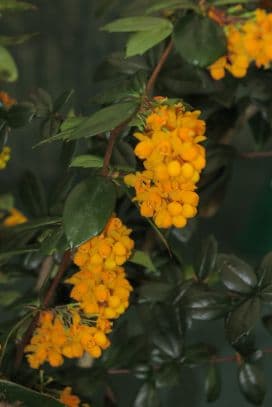
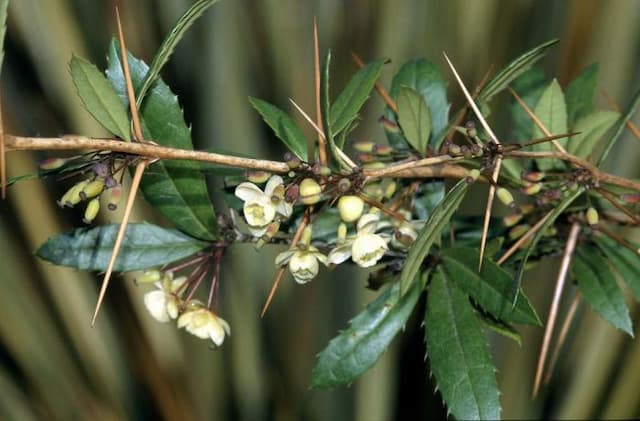
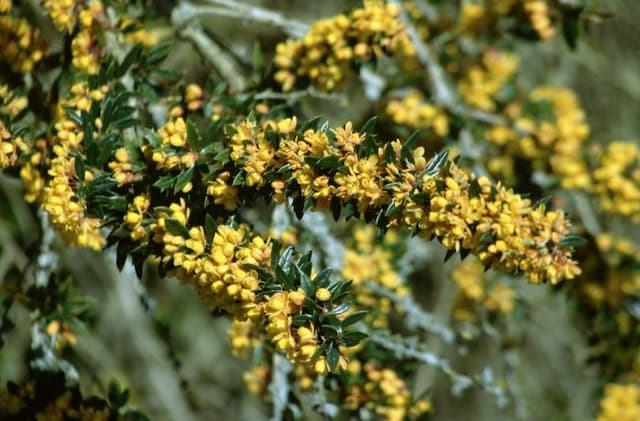
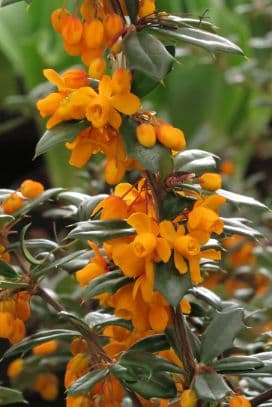
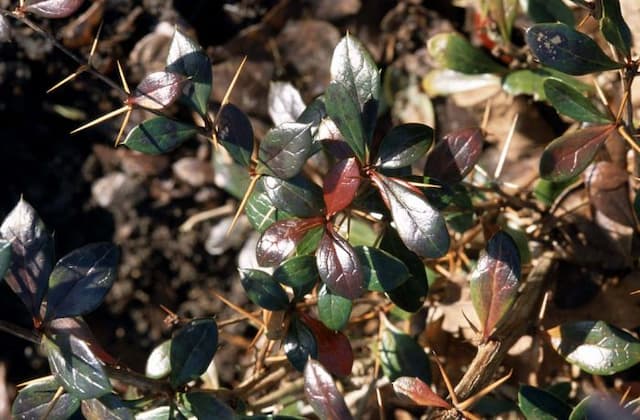


![Japanese barberry [Bonanza Gold]](/_next/image?url=https%3A%2F%2Fplants-admin.emdemapps.com%2Fimages%2Fplants%2F%2Fimages%2F604b5385e413f.png&w=640&q=75)
